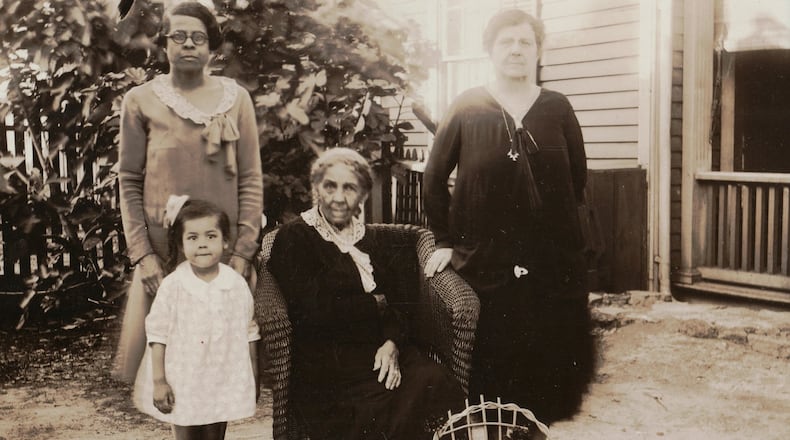When a community is erased, sometimes only the voices of the dead can tell its stories.
That is why people such as Laurel Wilson and Clara Axam spend so much time in graveyards. “Cemeteries tell you a lot,” said Axam. “They tell stories you can’t even fathom, if you’re willing to listen.”
One day three years ago, Wilson, a young, white historian, and Axam, an older, influential member of Atlanta's black community, strolled through the venerable Decatur Cemetery. They went to meet Axam's great-great-grandmother, a woman who catered fine parties in Decatur and was known for the beautiful linen and china of her place settings.
Her name was Sallie Durham. Born into slavery at Gov. Wilson Lumpkin's Athens home, she came to Decatur after emancipation, and started a thriving catering business.
But evidence of her life in Decatur was hard to find. Axam had not seen a photo of Sallie Durham’s face until the previous week. She was just moving to Decatur from Atlanta and was going through boxes in the attic, in an effort to downsize, when she was excited to find a photo of four generations of ancestors. Then, on a neighborhood website, she chanced upon Wilson, a graduate student researching black history.
At their first meeting, Wilson asked her, would you like to see where your great-great-grandmother is buried?
"All I could do is look at her," said Axam, 70, an attorney who has served in two mayoral cabinets, on the MARTA board and with the 1996 Olympics organizers. "That was the first time I went to her grave. And I have been visiting ever since. I take my children and my grandchildren. For me, it's like a spiritual moment."
Laurel Wilson, 41, is a California transplant with a master’s degree in heritage preservation from Georgia State University and a fascination with untold histories. She has traced her own lineage back to a woman tried as a witch in Salem.
For the past five years, she has been carefully examining the headstones and cemetery records in Section 6 of the Decatur Cemetery, the area available to African Americans during the graveyard’s segregated history.
She’s found more than 900 names. With the help of other documents, she’s been able to get a peek into turn-of-the-century black Decatur.
It was a lively scene.
Henry Oliver was an early arrival. A blacksmith and a successful businessman, he lived in Decatur for the last half of the 19th century, moving there from what was called Marthasville but eventually became Atlanta.
He inherited land from his father and sold it off to both white and black customers. He ran a blacksmithing operation and grew crops. A major road that ran through the center of town was named after him.
Former Mayor Elizabeth Wilson, 87, who moved to Decatur in 1949, said that in the de facto black part of town, the area west of the square and north of Agnes Scott, there were eight churches, shops, a movie theater and a black-owned cab company that transported women to their jobs as domestic workers.
The first school for African American children was built around 1901 by a black Presbyterian minister named Allen Wilson, she said. Herring Street School followed. During the 1950s, two “equalization” schools, Beacon Elementary and Trinity High School, were built by the city in the area that came to be known as the Beacon community.
“We had our schools. We had churches. We had our businesses. We had our recreation,” said Wilson. “And the best part is that we were like a family: Everybody knew everybody.”
But those schools — and much of the evidence of that world — are gone. As the neighborhood changed, through urban renewal and other forces, residents were moved to parts of Scottdale, or moved themselves to Winnona Park or south of town or to Atlanta. Section 8 housing went up. Streets disappeared.
“For me, the headstones are the only physical reminder of the fact that these black people ever existed,” said Wilson. “Beacon Hill is gone; The Bottom (which predated Beacon) is gone. All the buildings are gone. African Americans had a community here for 140 years. It’s gone, but these headstones still remain.”
Advocates are trying to recapture some of that history.
Wilson has successfully lobbied for “toppers” to go on street signs in the old Beacon neighborhood, which will help explain its past life as the center of Decatur’s thriving black world.
Urban renewal took away Oliver’s house, and Decatur changed the name of his road to Commerce Drive. Oliver was buried in the Decatur Cemetery, but he remained invisible there, too. For 115 years, his grave had no marker.
Due in part to Laurel Wilson’s detective work, the Friends of Decatur Cemetery have paid for a headstone marking Oliver’s resting place. That stone will be dedicated Oct. 6 in a ceremony at the cemetery, according to the city’s cemetery specialist, Zack Ray.
Oliver’s great-granddaughter Sylvia Clark will be at the dedication. She grew up on White Street, playing piano and getting into trouble. She still lived there as a young mother until the city started tearing down houses on her block in the 1970s. Then Decatur hoisted an antebellum house onto a truck and moved it into Clark’s old neighborhood.
That house was owned by 19th-century writer and Confederate apologist Mary Gay, author of "Life in Dixie During the Civil War."
Gay has been celebrated as a plucky Scarlett O’Hara type, but the positive attention irks Laurel Wilson, considering the fact that Gay enslaved six African Americans. Today the Mary Gay House is used as a wedding facility. Part of White Street is now Mary Gay Drive, said Clark.
Clark, 77, moved south of town to a brick house surrounded by gardens in a neighborhood off of Candler Road. She’s an avocational artist, and the house is full of her paintings and drawings of The Bottom and scenes from her childhood. She’s proud that she still has a Decatur address, but sad when she walks around her old stomping ground. “It breaks my heart to come to Decatur now.”
Clark was in town recently to hear Wilson, the historian, discuss her research at a "lunch and learn" sponsored by the DeKalb History Center at the old DeKalb County Courthouse. Wilson talked about the nearly 200 slaves sold on the steps of that very building between 1831 and 1863. She described Klan parades through town and Decatur's ordinances in 1915 and 1938 segregating the city block by block.
“There is no evidence that this ordinance has been repealed,” she said pointedly.
She also spoke about the black Republicans who ran for public office during Reconstruction. It wasn't until more than 100 years later that a black person was elected to the City Council, Wilson said, showing a slide of a very young-looking Elizabeth Wilson at her 1984 victory party.
An older and wiser Elizabeth Wilson smiled from the front row as the audience erupted into applause. “It was about time!” shouted Clark. Laurel Wilson wiped away tears.
The Decatur Cemetery, founded in 1823, is the oldest municipal cemetery in Atlanta, and, at 58 acres, is larger than Oakland Cemetery, the metro area's most prominent burial place. Decatur's facility boasts old-growth cedar trees and a spring-fed pond at the center.
There are 40,000 spaces, most of them full, except in the cinerarium, where a 4-by-4-foot plot for burying ashes costs $400.
“I was always scared of graveyards,” said Laurel Wilson, as she led the way up and down paths in the hilly graveyard one day. “Whenever I walked over the graves, I would say, ‘Excuse me! Sorry!’ Now I say, ‘Hi, how ya doin’?’”
Parts of the cemetery could use some loving care. Wilson pointed to cracked walkways and collapsed walls as she walked. A Section 6 marker for Maggie Jinks, who died in 1952, was hidden by an azalea bush until Wilson cut it back. “I didn’t know there was a grave here at all until I got a pair of clippers and trimmed that azalea.”
Ivy and other invasives will eat through brick walls, said Cathy Vogel, president of the Friends of Decatur Cemetery, and fighting ivy is a full-time job. Volunteers have their hands full, and the city doesn't always have the funds for repairs, she said.
“We’re not a huge foundation like Oakland,” she said. “We do what we can. In a city like Decatur, there’s a lot of infrastructure all over that needs to be done; somehow the cemetery is the last on the list.”
Using clippers and archives, Wilson has liberated much information from that resting place.
Clara Axam said she admires the work Wilson has done.
“I so appreciate Laurel’s sensitivity,” said Axam. “She’s not exploiting that history; she’s not co-opting that history. She has a natural inquisitiveness. She’s gotten hooked on the stories that have not been told, and the voices that could not be lifted.”
About the Author
Keep Reading
The Latest
Featured









